University Clinical Reasoning Assignment: Health Assessment CNA152
VerifiedAdded on 2022/12/30
|8
|1698
|23
Homework Assignment
AI Summary
This clinical reasoning assignment, focusing on a case study of a 16-year-old boy named Jonathan who experienced elevated vital signs during a bubble soccer match in hot weather, analyzes the patient's condition and assessment findings. The assignment begins with an introduction to the scenario, followed by an examination of objective and subjective data, including vital signs such as temperature, pulse, respiratory rate, and blood pressure. It analyzes and interprets these cues, comparing them to Jonathan's previous readings and normal ranges, and then explains the physiological responses to exercise, such as increased metabolism, oxygen demand, and blood flow, maintaining homeostasis. The assignment also suggests additional cues like weight and blood glucose levels, and emphasizes the importance of rest and fluid intake. The document references several sources to support its analysis.
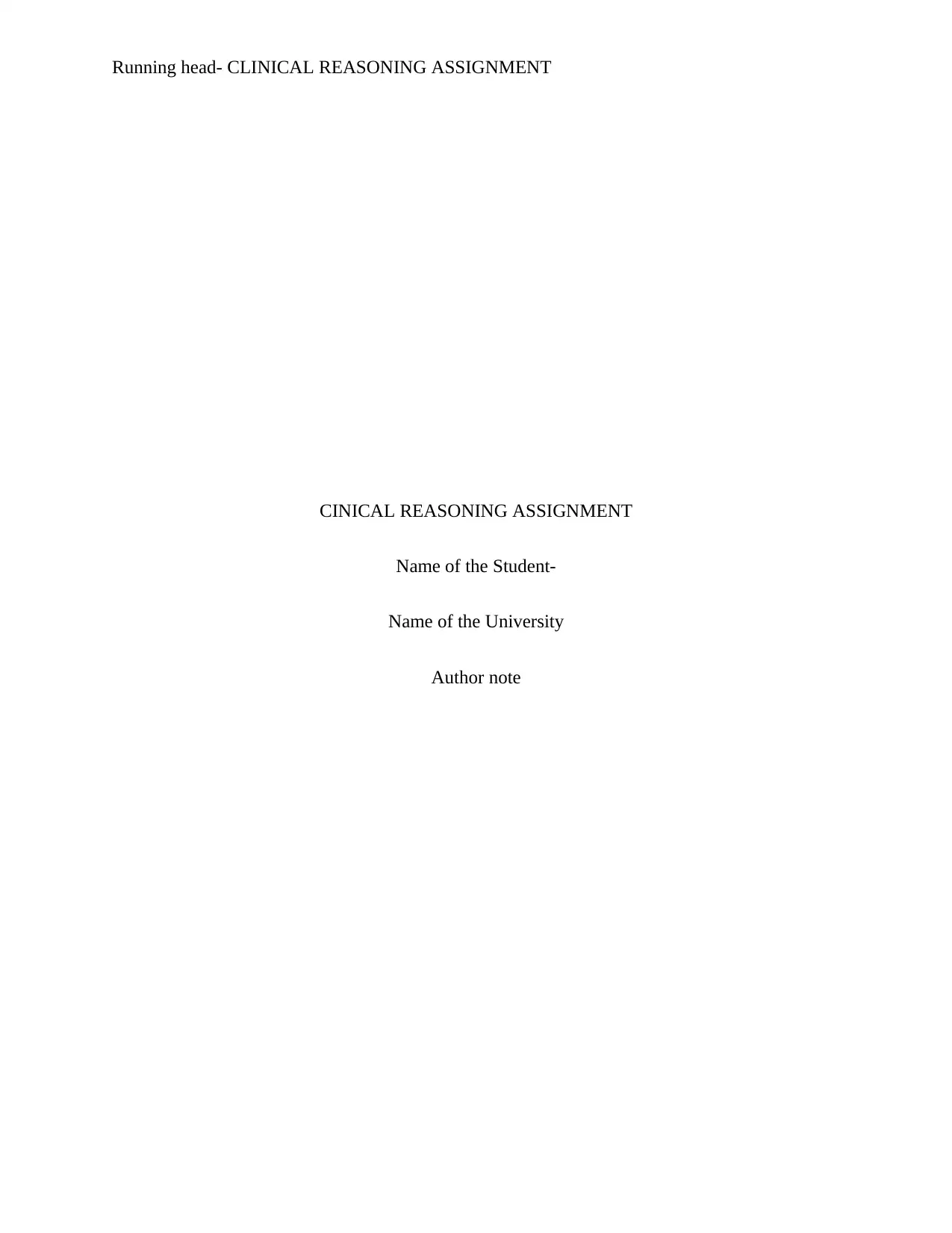
Running head- CLINICAL REASONING ASSIGNMENT
CINICAL REASONING ASSIGNMENT
Name of the Student-
Name of the University
Author note
CINICAL REASONING ASSIGNMENT
Name of the Student-
Name of the University
Author note
Paraphrase This Document
Need a fresh take? Get an instant paraphrase of this document with our AI Paraphraser
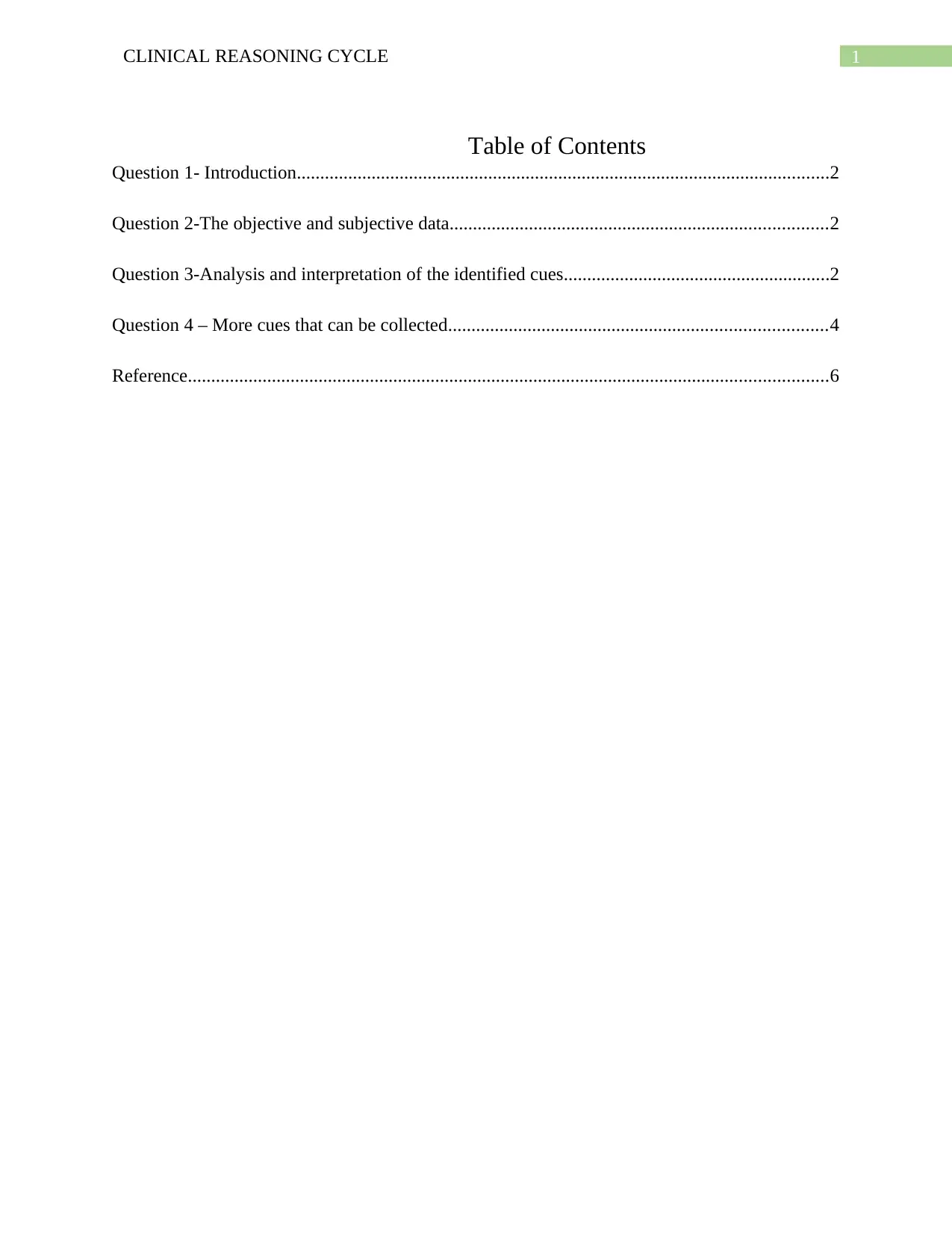
1CLINICAL REASONING CYCLE
Table of Contents
Question 1- Introduction..................................................................................................................2
Question 2-The objective and subjective data.................................................................................2
Question 3-Analysis and interpretation of the identified cues.........................................................2
Question 4 – More cues that can be collected.................................................................................4
Reference.........................................................................................................................................6
Table of Contents
Question 1- Introduction..................................................................................................................2
Question 2-The objective and subjective data.................................................................................2
Question 3-Analysis and interpretation of the identified cues.........................................................2
Question 4 – More cues that can be collected.................................................................................4
Reference.........................................................................................................................................6
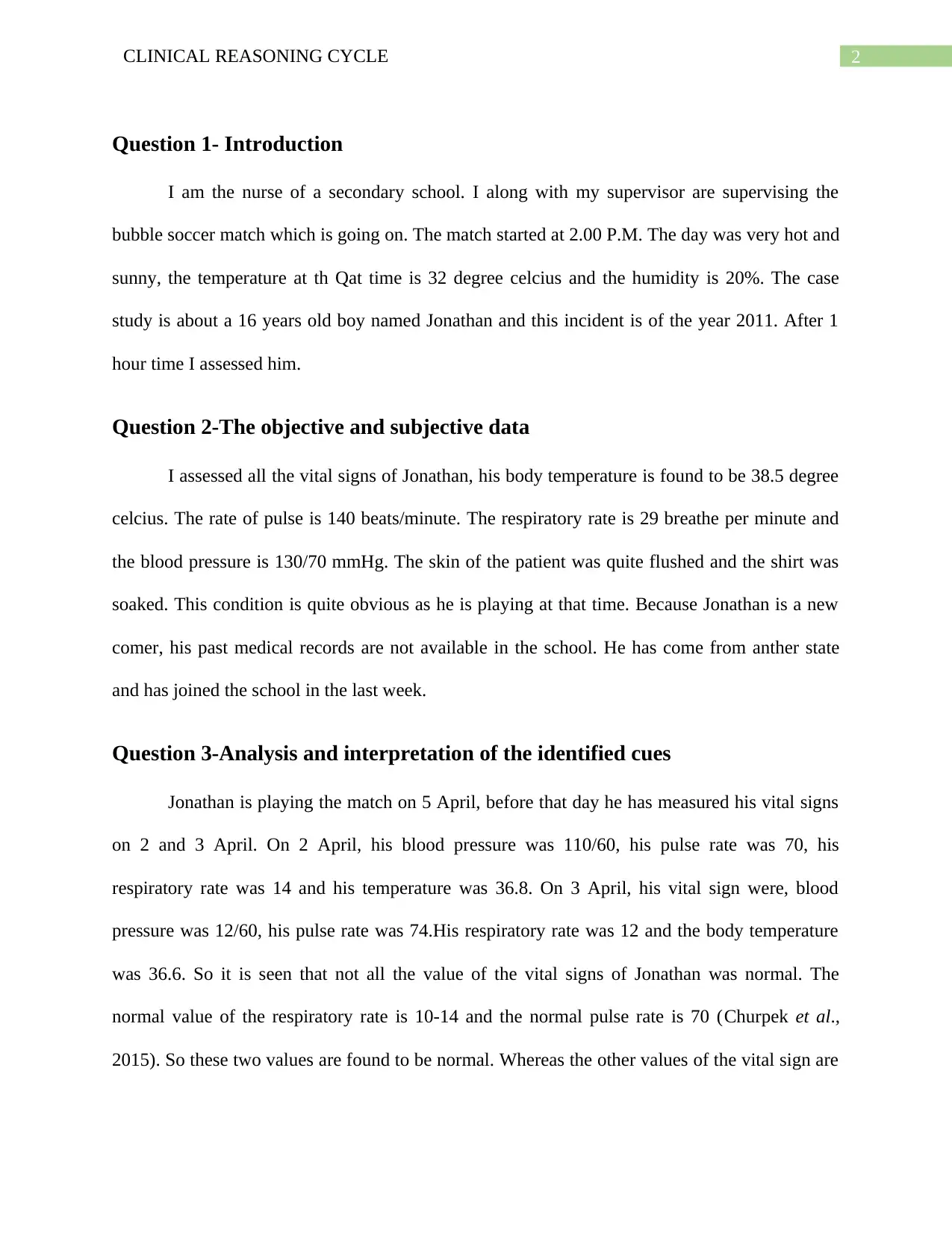
2CLINICAL REASONING CYCLE
Question 1- Introduction
I am the nurse of a secondary school. I along with my supervisor are supervising the
bubble soccer match which is going on. The match started at 2.00 P.M. The day was very hot and
sunny, the temperature at th Qat time is 32 degree celcius and the humidity is 20%. The case
study is about a 16 years old boy named Jonathan and this incident is of the year 2011. After 1
hour time I assessed him.
Question 2-The objective and subjective data
I assessed all the vital signs of Jonathan, his body temperature is found to be 38.5 degree
celcius. The rate of pulse is 140 beats/minute. The respiratory rate is 29 breathe per minute and
the blood pressure is 130/70 mmHg. The skin of the patient was quite flushed and the shirt was
soaked. This condition is quite obvious as he is playing at that time. Because Jonathan is a new
comer, his past medical records are not available in the school. He has come from anther state
and has joined the school in the last week.
Question 3-Analysis and interpretation of the identified cues
Jonathan is playing the match on 5 April, before that day he has measured his vital signs
on 2 and 3 April. On 2 April, his blood pressure was 110/60, his pulse rate was 70, his
respiratory rate was 14 and his temperature was 36.8. On 3 April, his vital sign were, blood
pressure was 12/60, his pulse rate was 74.His respiratory rate was 12 and the body temperature
was 36.6. So it is seen that not all the value of the vital signs of Jonathan was normal. The
normal value of the respiratory rate is 10-14 and the normal pulse rate is 70 (Churpek et al.,
2015). So these two values are found to be normal. Whereas the other values of the vital sign are
Question 1- Introduction
I am the nurse of a secondary school. I along with my supervisor are supervising the
bubble soccer match which is going on. The match started at 2.00 P.M. The day was very hot and
sunny, the temperature at th Qat time is 32 degree celcius and the humidity is 20%. The case
study is about a 16 years old boy named Jonathan and this incident is of the year 2011. After 1
hour time I assessed him.
Question 2-The objective and subjective data
I assessed all the vital signs of Jonathan, his body temperature is found to be 38.5 degree
celcius. The rate of pulse is 140 beats/minute. The respiratory rate is 29 breathe per minute and
the blood pressure is 130/70 mmHg. The skin of the patient was quite flushed and the shirt was
soaked. This condition is quite obvious as he is playing at that time. Because Jonathan is a new
comer, his past medical records are not available in the school. He has come from anther state
and has joined the school in the last week.
Question 3-Analysis and interpretation of the identified cues
Jonathan is playing the match on 5 April, before that day he has measured his vital signs
on 2 and 3 April. On 2 April, his blood pressure was 110/60, his pulse rate was 70, his
respiratory rate was 14 and his temperature was 36.8. On 3 April, his vital sign were, blood
pressure was 12/60, his pulse rate was 74.His respiratory rate was 12 and the body temperature
was 36.6. So it is seen that not all the value of the vital signs of Jonathan was normal. The
normal value of the respiratory rate is 10-14 and the normal pulse rate is 70 (Churpek et al.,
2015). So these two values are found to be normal. Whereas the other values of the vital sign are
⊘ This is a preview!⊘
Do you want full access?
Subscribe today to unlock all pages.

Trusted by 1+ million students worldwide
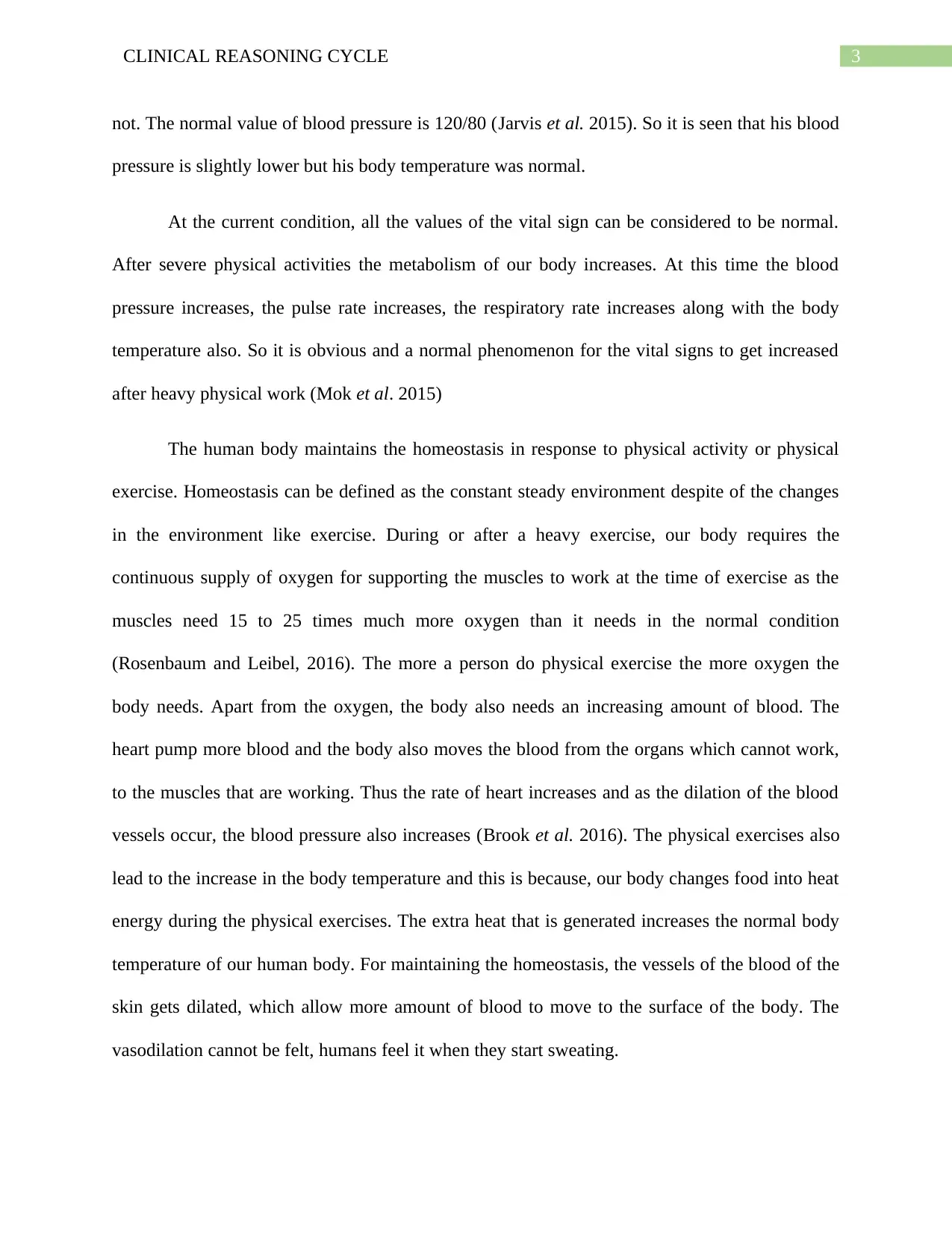
3CLINICAL REASONING CYCLE
not. The normal value of blood pressure is 120/80 (Jarvis et al. 2015). So it is seen that his blood
pressure is slightly lower but his body temperature was normal.
At the current condition, all the values of the vital sign can be considered to be normal.
After severe physical activities the metabolism of our body increases. At this time the blood
pressure increases, the pulse rate increases, the respiratory rate increases along with the body
temperature also. So it is obvious and a normal phenomenon for the vital signs to get increased
after heavy physical work (Mok et al. 2015)
The human body maintains the homeostasis in response to physical activity or physical
exercise. Homeostasis can be defined as the constant steady environment despite of the changes
in the environment like exercise. During or after a heavy exercise, our body requires the
continuous supply of oxygen for supporting the muscles to work at the time of exercise as the
muscles need 15 to 25 times much more oxygen than it needs in the normal condition
(Rosenbaum and Leibel, 2016). The more a person do physical exercise the more oxygen the
body needs. Apart from the oxygen, the body also needs an increasing amount of blood. The
heart pump more blood and the body also moves the blood from the organs which cannot work,
to the muscles that are working. Thus the rate of heart increases and as the dilation of the blood
vessels occur, the blood pressure also increases (Brook et al. 2016). The physical exercises also
lead to the increase in the body temperature and this is because, our body changes food into heat
energy during the physical exercises. The extra heat that is generated increases the normal body
temperature of our human body. For maintaining the homeostasis, the vessels of the blood of the
skin gets dilated, which allow more amount of blood to move to the surface of the body. The
vasodilation cannot be felt, humans feel it when they start sweating.
not. The normal value of blood pressure is 120/80 (Jarvis et al. 2015). So it is seen that his blood
pressure is slightly lower but his body temperature was normal.
At the current condition, all the values of the vital sign can be considered to be normal.
After severe physical activities the metabolism of our body increases. At this time the blood
pressure increases, the pulse rate increases, the respiratory rate increases along with the body
temperature also. So it is obvious and a normal phenomenon for the vital signs to get increased
after heavy physical work (Mok et al. 2015)
The human body maintains the homeostasis in response to physical activity or physical
exercise. Homeostasis can be defined as the constant steady environment despite of the changes
in the environment like exercise. During or after a heavy exercise, our body requires the
continuous supply of oxygen for supporting the muscles to work at the time of exercise as the
muscles need 15 to 25 times much more oxygen than it needs in the normal condition
(Rosenbaum and Leibel, 2016). The more a person do physical exercise the more oxygen the
body needs. Apart from the oxygen, the body also needs an increasing amount of blood. The
heart pump more blood and the body also moves the blood from the organs which cannot work,
to the muscles that are working. Thus the rate of heart increases and as the dilation of the blood
vessels occur, the blood pressure also increases (Brook et al. 2016). The physical exercises also
lead to the increase in the body temperature and this is because, our body changes food into heat
energy during the physical exercises. The extra heat that is generated increases the normal body
temperature of our human body. For maintaining the homeostasis, the vessels of the blood of the
skin gets dilated, which allow more amount of blood to move to the surface of the body. The
vasodilation cannot be felt, humans feel it when they start sweating.
Paraphrase This Document
Need a fresh take? Get an instant paraphrase of this document with our AI Paraphraser
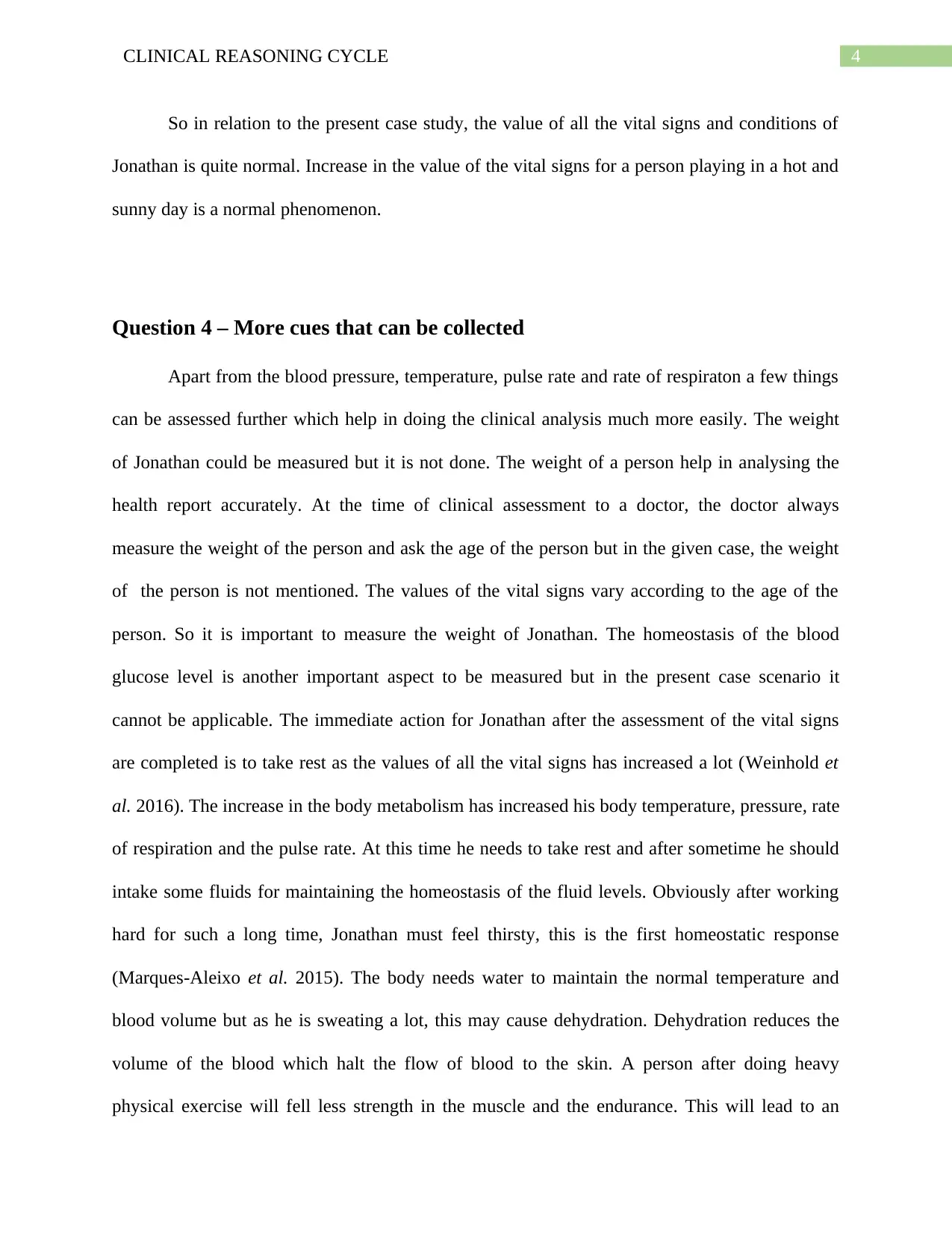
4CLINICAL REASONING CYCLE
So in relation to the present case study, the value of all the vital signs and conditions of
Jonathan is quite normal. Increase in the value of the vital signs for a person playing in a hot and
sunny day is a normal phenomenon.
Question 4 – More cues that can be collected
Apart from the blood pressure, temperature, pulse rate and rate of respiraton a few things
can be assessed further which help in doing the clinical analysis much more easily. The weight
of Jonathan could be measured but it is not done. The weight of a person help in analysing the
health report accurately. At the time of clinical assessment to a doctor, the doctor always
measure the weight of the person and ask the age of the person but in the given case, the weight
of the person is not mentioned. The values of the vital signs vary according to the age of the
person. So it is important to measure the weight of Jonathan. The homeostasis of the blood
glucose level is another important aspect to be measured but in the present case scenario it
cannot be applicable. The immediate action for Jonathan after the assessment of the vital signs
are completed is to take rest as the values of all the vital signs has increased a lot (Weinhold et
al. 2016). The increase in the body metabolism has increased his body temperature, pressure, rate
of respiration and the pulse rate. At this time he needs to take rest and after sometime he should
intake some fluids for maintaining the homeostasis of the fluid levels. Obviously after working
hard for such a long time, Jonathan must feel thirsty, this is the first homeostatic response
(Marques-Aleixo et al. 2015). The body needs water to maintain the normal temperature and
blood volume but as he is sweating a lot, this may cause dehydration. Dehydration reduces the
volume of the blood which halt the flow of blood to the skin. A person after doing heavy
physical exercise will fell less strength in the muscle and the endurance. This will lead to an
So in relation to the present case study, the value of all the vital signs and conditions of
Jonathan is quite normal. Increase in the value of the vital signs for a person playing in a hot and
sunny day is a normal phenomenon.
Question 4 – More cues that can be collected
Apart from the blood pressure, temperature, pulse rate and rate of respiraton a few things
can be assessed further which help in doing the clinical analysis much more easily. The weight
of Jonathan could be measured but it is not done. The weight of a person help in analysing the
health report accurately. At the time of clinical assessment to a doctor, the doctor always
measure the weight of the person and ask the age of the person but in the given case, the weight
of the person is not mentioned. The values of the vital signs vary according to the age of the
person. So it is important to measure the weight of Jonathan. The homeostasis of the blood
glucose level is another important aspect to be measured but in the present case scenario it
cannot be applicable. The immediate action for Jonathan after the assessment of the vital signs
are completed is to take rest as the values of all the vital signs has increased a lot (Weinhold et
al. 2016). The increase in the body metabolism has increased his body temperature, pressure, rate
of respiration and the pulse rate. At this time he needs to take rest and after sometime he should
intake some fluids for maintaining the homeostasis of the fluid levels. Obviously after working
hard for such a long time, Jonathan must feel thirsty, this is the first homeostatic response
(Marques-Aleixo et al. 2015). The body needs water to maintain the normal temperature and
blood volume but as he is sweating a lot, this may cause dehydration. Dehydration reduces the
volume of the blood which halt the flow of blood to the skin. A person after doing heavy
physical exercise will fell less strength in the muscle and the endurance. This will lead to an
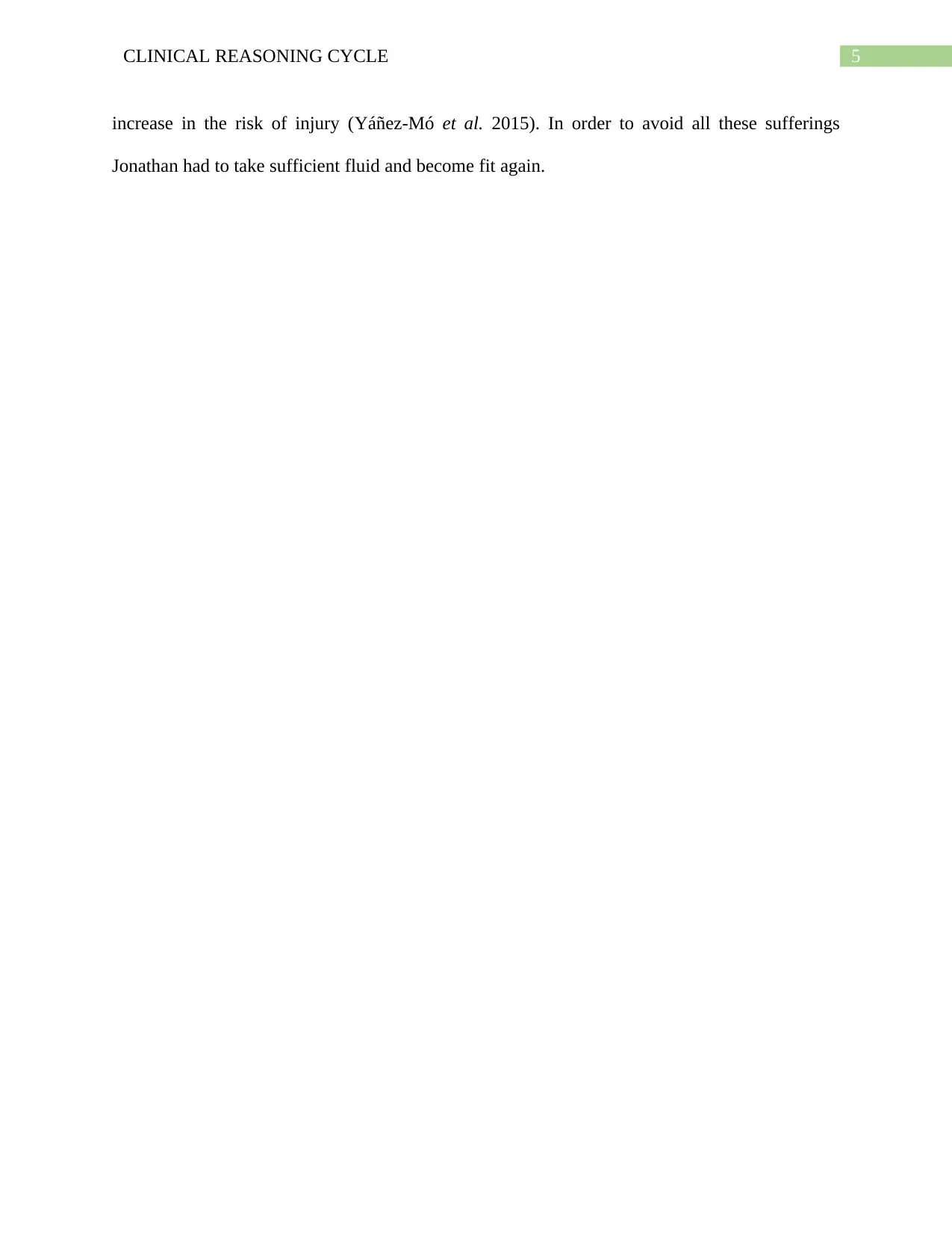
5CLINICAL REASONING CYCLE
increase in the risk of injury (Yáñez-Mó et al. 2015). In order to avoid all these sufferings
Jonathan had to take sufficient fluid and become fit again.
increase in the risk of injury (Yáñez-Mó et al. 2015). In order to avoid all these sufferings
Jonathan had to take sufficient fluid and become fit again.
⊘ This is a preview!⊘
Do you want full access?
Subscribe today to unlock all pages.

Trusted by 1+ million students worldwide
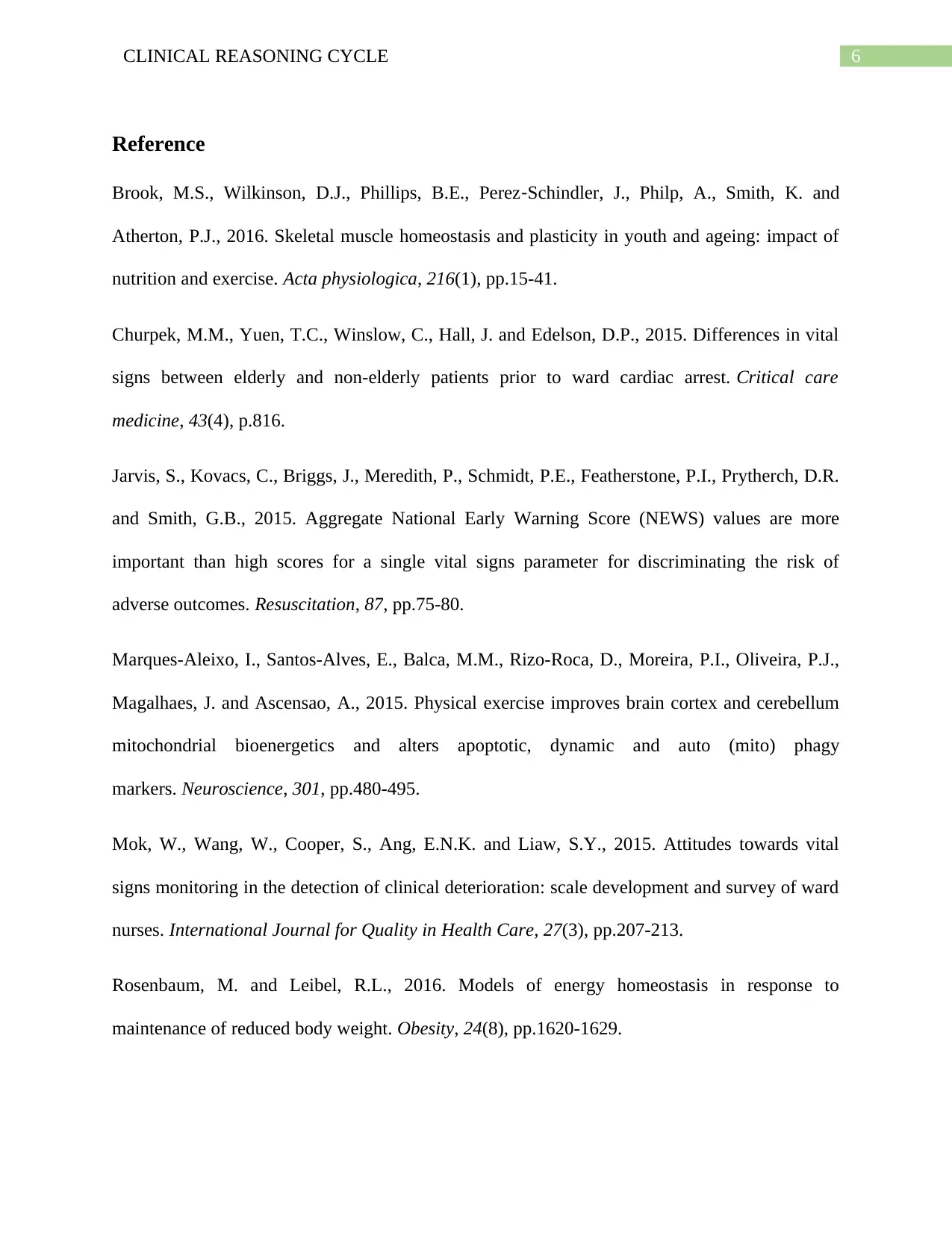
6CLINICAL REASONING CYCLE
Reference
Brook, M.S., Wilkinson, D.J., Phillips, B.E., Perez‐Schindler, J., Philp, A., Smith, K. and
Atherton, P.J., 2016. Skeletal muscle homeostasis and plasticity in youth and ageing: impact of
nutrition and exercise. Acta physiologica, 216(1), pp.15-41.
Churpek, M.M., Yuen, T.C., Winslow, C., Hall, J. and Edelson, D.P., 2015. Differences in vital
signs between elderly and non-elderly patients prior to ward cardiac arrest. Critical care
medicine, 43(4), p.816.
Jarvis, S., Kovacs, C., Briggs, J., Meredith, P., Schmidt, P.E., Featherstone, P.I., Prytherch, D.R.
and Smith, G.B., 2015. Aggregate National Early Warning Score (NEWS) values are more
important than high scores for a single vital signs parameter for discriminating the risk of
adverse outcomes. Resuscitation, 87, pp.75-80.
Marques-Aleixo, I., Santos-Alves, E., Balca, M.M., Rizo-Roca, D., Moreira, P.I., Oliveira, P.J.,
Magalhaes, J. and Ascensao, A., 2015. Physical exercise improves brain cortex and cerebellum
mitochondrial bioenergetics and alters apoptotic, dynamic and auto (mito) phagy
markers. Neuroscience, 301, pp.480-495.
Mok, W., Wang, W., Cooper, S., Ang, E.N.K. and Liaw, S.Y., 2015. Attitudes towards vital
signs monitoring in the detection of clinical deterioration: scale development and survey of ward
nurses. International Journal for Quality in Health Care, 27(3), pp.207-213.
Rosenbaum, M. and Leibel, R.L., 2016. Models of energy homeostasis in response to
maintenance of reduced body weight. Obesity, 24(8), pp.1620-1629.
Reference
Brook, M.S., Wilkinson, D.J., Phillips, B.E., Perez‐Schindler, J., Philp, A., Smith, K. and
Atherton, P.J., 2016. Skeletal muscle homeostasis and plasticity in youth and ageing: impact of
nutrition and exercise. Acta physiologica, 216(1), pp.15-41.
Churpek, M.M., Yuen, T.C., Winslow, C., Hall, J. and Edelson, D.P., 2015. Differences in vital
signs between elderly and non-elderly patients prior to ward cardiac arrest. Critical care
medicine, 43(4), p.816.
Jarvis, S., Kovacs, C., Briggs, J., Meredith, P., Schmidt, P.E., Featherstone, P.I., Prytherch, D.R.
and Smith, G.B., 2015. Aggregate National Early Warning Score (NEWS) values are more
important than high scores for a single vital signs parameter for discriminating the risk of
adverse outcomes. Resuscitation, 87, pp.75-80.
Marques-Aleixo, I., Santos-Alves, E., Balca, M.M., Rizo-Roca, D., Moreira, P.I., Oliveira, P.J.,
Magalhaes, J. and Ascensao, A., 2015. Physical exercise improves brain cortex and cerebellum
mitochondrial bioenergetics and alters apoptotic, dynamic and auto (mito) phagy
markers. Neuroscience, 301, pp.480-495.
Mok, W., Wang, W., Cooper, S., Ang, E.N.K. and Liaw, S.Y., 2015. Attitudes towards vital
signs monitoring in the detection of clinical deterioration: scale development and survey of ward
nurses. International Journal for Quality in Health Care, 27(3), pp.207-213.
Rosenbaum, M. and Leibel, R.L., 2016. Models of energy homeostasis in response to
maintenance of reduced body weight. Obesity, 24(8), pp.1620-1629.
Paraphrase This Document
Need a fresh take? Get an instant paraphrase of this document with our AI Paraphraser
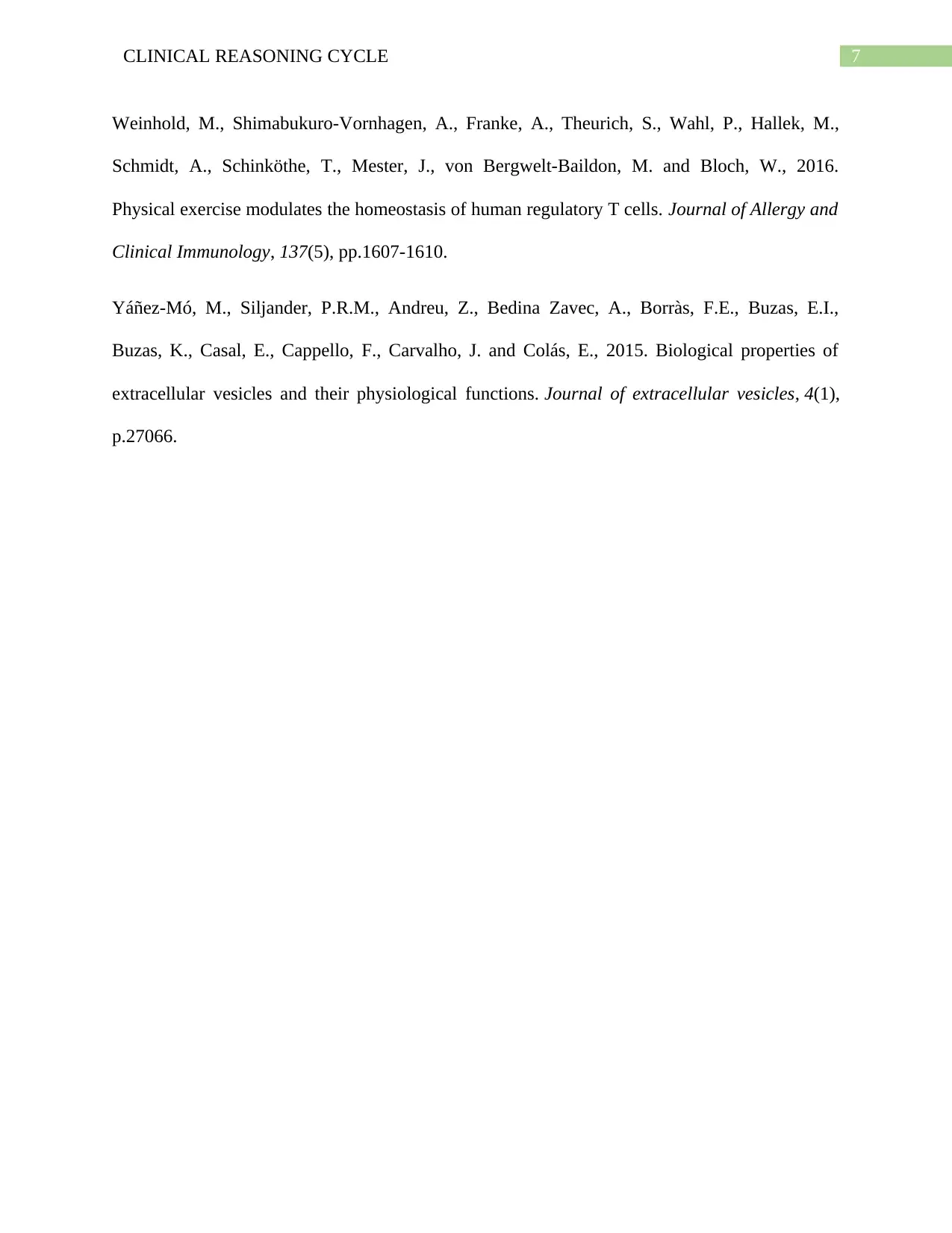
7CLINICAL REASONING CYCLE
Weinhold, M., Shimabukuro-Vornhagen, A., Franke, A., Theurich, S., Wahl, P., Hallek, M.,
Schmidt, A., Schinköthe, T., Mester, J., von Bergwelt-Baildon, M. and Bloch, W., 2016.
Physical exercise modulates the homeostasis of human regulatory T cells. Journal of Allergy and
Clinical Immunology, 137(5), pp.1607-1610.
Yáñez-Mó, M., Siljander, P.R.M., Andreu, Z., Bedina Zavec, A., Borràs, F.E., Buzas, E.I.,
Buzas, K., Casal, E., Cappello, F., Carvalho, J. and Colás, E., 2015. Biological properties of
extracellular vesicles and their physiological functions. Journal of extracellular vesicles, 4(1),
p.27066.
Weinhold, M., Shimabukuro-Vornhagen, A., Franke, A., Theurich, S., Wahl, P., Hallek, M.,
Schmidt, A., Schinköthe, T., Mester, J., von Bergwelt-Baildon, M. and Bloch, W., 2016.
Physical exercise modulates the homeostasis of human regulatory T cells. Journal of Allergy and
Clinical Immunology, 137(5), pp.1607-1610.
Yáñez-Mó, M., Siljander, P.R.M., Andreu, Z., Bedina Zavec, A., Borràs, F.E., Buzas, E.I.,
Buzas, K., Casal, E., Cappello, F., Carvalho, J. and Colás, E., 2015. Biological properties of
extracellular vesicles and their physiological functions. Journal of extracellular vesicles, 4(1),
p.27066.
1 out of 8
Related Documents
Your All-in-One AI-Powered Toolkit for Academic Success.
+13062052269
info@desklib.com
Available 24*7 on WhatsApp / Email
![[object Object]](/_next/static/media/star-bottom.7253800d.svg)
Unlock your academic potential
Copyright © 2020–2025 A2Z Services. All Rights Reserved. Developed and managed by ZUCOL.





